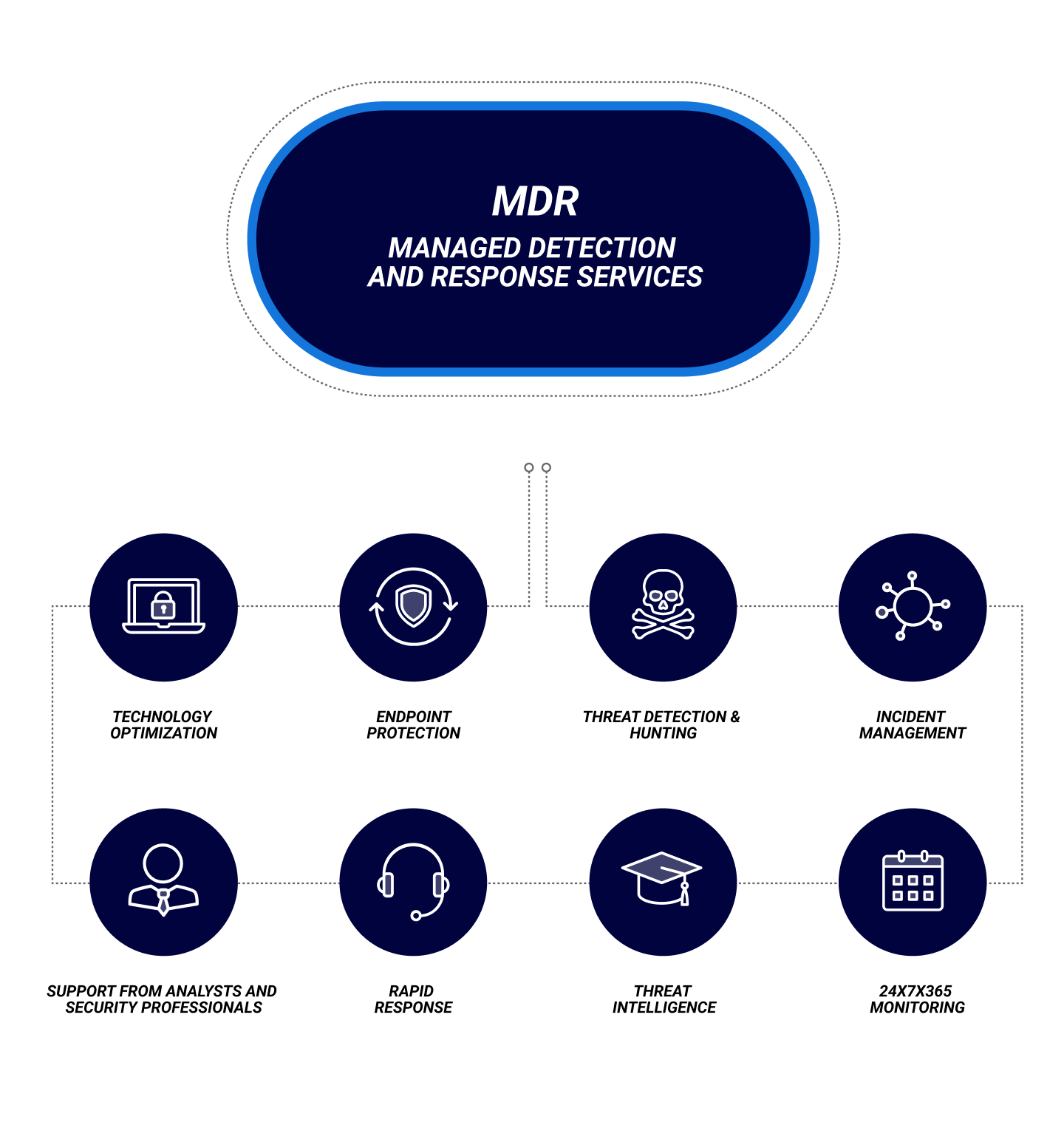What Is Managed Detection and Response?

Benefits of Managed Detection and Response
The key benefits of MDR are:
- Access to experienced Security Operations Center (SOC) analysts to bridge internal skill gaps
- Improved incident management, incident response, and remediation processes
- Proactive threat detection and threat hunting
- Better risk management and vulnerability management
- More effective alert and notification triaging
- Improved security and risk posture for employees and customers
- Reduced total cost of ownership compared to traditional EDR
There is no end in sight to the ongoing cybersecurity skills shortage across the world. SOC teams struggle to do more with less, even as they face a threat landscape populated by increasingly sophisticated, organized, and well-funded cyber criminals. IT personnel are exhausted, overworked, and overwhelmed.
MDR is designed to connect businesses with teams of cybersecurity experts, significantly reducing the burden on internal security teams. By enabling the business to bridge gaps in their security infrastructure and expertise, MDR helps solve the cybersecurity talent gap. With MDR, organizations can pursue a mature, effective security program that encompasses both cybersecurity and cyber resilience.
More MDR benefits:
- Consolidates detection, remediation, and administration into a single dashboard
- Reduces the time spent detecting and responding to threats significantly
- Frees internal resources to focus on other mission-critical processes
- Eases compliance and reporting
- Provides access to deep security and threat prevention expertise
Managed Detection and Response Features
According to Gartner’s Market Guide for MDR Services, the core features of an MDR offering include:
- A technology stack owned and managed by the service provider that enables real-time threat monitoring, detection, and investigation alongside active mitigation and response
- Expert staff that engages with deals daily with client data
- A standardized playbook for security procedures, workflow management, and analytics
- Remote mitigation, investigation, and containment
- Centralized detection, mitigation, and reporting functionality
- A security service provider fully owns how threats are detected, identified, and validated
- Reduced time between detection and mitigation
- Generation and collection of security log data and alerts at multiple security layers
- A combination of manual and automated mitigation processes, including account lockout, host isolation, and network blocking
Other MDR features include:
- 24x7x365 threat monitoring, detection, and response
- AI-powered endpoint protection
- Incident/event management and response
- Exposure, notification, and compliance management
- Preauthorized and customizable analyst interactions and interventions
- Advanced orchestration
- Tailored triage and filtering methods
- Organized, contextualized telemetry
Gartner also notes that MDR services are expanding to include technologies and coverage beyond traditional EDR, as described by Managed XDR.
How Managed Detection and Response Works
Given that MDR is simply a managed services framework layered on EDR, MDR serves essentially the same purpose as EDR. MDR prevents and protects an organization’s network from cyber threats, providing the basic functionality of EDR and EPP as well as the guidance and expertise necessary to use that functionality fully. This guidance may take many forms but typically includes one or more of the following:
- Red team and attack simulation
- Penetration testing
- Strategic risk management
- Incident reporting, response, and forensics
- Compromise assessment
Use Cases for Managed Detection and Response Services
Augmenting an Organization's SOC
Many SOCs struggle to keep up with cybersecurity demands:
- SIEM configuration is a logistical nightmare.
- They’re flooded with notifications from all sides.
- Visibility is muddied at best.
MDR provides these security teams with relief and contribute the service provider’s expertise as well as a robust suite of security tools.
Serving as a Remote SOC
The best way to describe the relationship between MDR and Managed XDR is to compare it to the relationship between Extended Detection and Response (XDR) and EDR. XDR is an upgrade from EDR; so, too, is Managed XDR an upgrade from MDR.
XDR extends an organization’s EDR capabilities while adding advanced threat intelligence as well as protections at the network, server, cloud, and application levels. Similarly, Managed XDR enhances the MDR framework by adding XDR functionality.
FAQ
What is MDR?
Managed Detection and Response (MDR) is a framework through which an EDR solution is delivered as a managed service, complete with 24x7 monitoring and expert guidance.
What’s the difference between MDR and Managed XDR?
Managed XDR, also called MXDR, is an upgrade from MDR. Managed XDR provides all the features and functionality of MDR while also introducing new security protections and enhanced threat intelligence.
Is MDR the same as Professional Cybersecurity Services?
While MDR is itself a managed service, MDR providers take a more in-depth approach than typical Managed Security Service Providers (MSSPs). With MDR, security professionals directly engage with the client organization on a 24/7 basis. With that said, MDR solutions and MSSP offerings frequently complement one another.
Why is MDR important?
Organizations face ever-expanding attack surfaces and more sophisticated cyber threats, yet their security teams and budgets aren't keeping up. MDR offers a solution by providing a cost-effective means of leveraging top-tier cybersecurity expertise and technology.